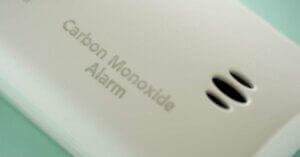
Carbon monoxide or carbon dioxide?
While they’re easy to confuse, both carbon monoxide and carbon dioxide are deadly colorless and odorless gases. Carbon dioxide naturally occurs in the atmosphere, whereas carbon monoxide is generally produced by non-electrical fuel-burning appliances such as propane heaters, wood-burning fireplaces, oil-burning furnaces, and fuel-burning combustion vehicles like cars and recreational transportation. Carbon monoxide is also naturally generated by Mother Nature during volcanic eruptions and forest fires.
How does carbon monoxide poisoning happen?
When temperatures drop and people get cold during winter, they often want to warm up in any way possible. Unfortunately, this also means they may not be making the wisest of decisions in the name of keeping cozy. It’s almost too easy to grab that kerosene heater or to warm up your car in the garage before heading off to work, but that’s exactly where the problem can start. Carbon monoxide can be generated without you being aware of the impending hazardous consequences.
What are the symptoms of CO poisoning?
According to the CDC, these are the most common symptoms of carbon monoxide poisoning:
- chest pain
- confusion
- dizziness
- fatigue
- headache
- loss of muscle coordination
- nausea
- vomiting
- weakness
If you’ve been consuming alcohol or have been sleeping, you’re even more vulnerable to the effects of deadly carbon monoxide.
Here’s how you can prevent carbon monoxide poisoning.
As outlined in the comprehensive DomiDocs New Homeowner’s Guide for the digital-first generation, tips for preventing CO poisoning include:
- regularly cleaning and inspecting your wood-burning fireplace
- scheduling an annual inspection with a professional heating, ventilation, and air conditioning (HVAC) contractor
- installing and replacing the batteries in your home’s carbon monoxide and smoke detectors every six months. Not sure you’ll remember? Use the handy home maintenance feature of DomiDocs that comes complete with calendar alerts.
Additional carbon monoxide poisoning prevention tips from the CDC include:
- ensuring good ventilation by keeping chimney flues and vents free of debris
- never using a camping stove, charcoal grill, lantern, or a hibachi inside a tent, home, or camper
- never running any type of gasoline-powered engine, including motor vehicles, inside a garage, basement, or an enclosed structure, even if there appears to be adequate ventilation by having the windows and doors open
Who is most at risk of CO poisoning in your household?
While carbon monoxide is dangerous to everyone, more vulnerable members of your household include:
- babies
- children
- elderly people
- pets
- people with previous respiratory health problems
- people with chronic heart disease
- pregnant women
Call 911
If you suspect carbon monoxide poisoning, call 911 or your health care professional and immediately evacuate everyone from the impacted area, if applicable. A blood test can confirm CO poisoning, while possible treatments include standard or hyperbaric oxygen therapy to replace the nasty toxins.
Remember that DomiDocs always has your back when it comes to simplified home management. Besides the convenient calendar alerts in the home maintenance feature, DomiDocs provides market value tracking, cloud-based document storage, and a nation-wide service provider list, as well as accounting and finance features.
Author – Connie Motz



